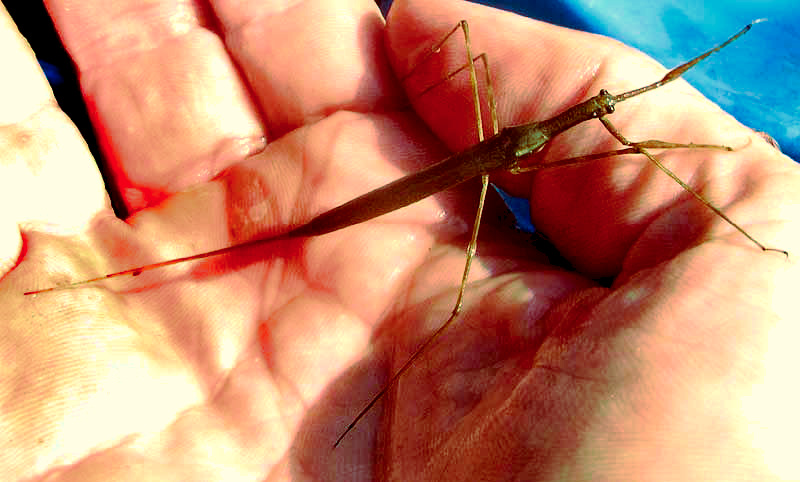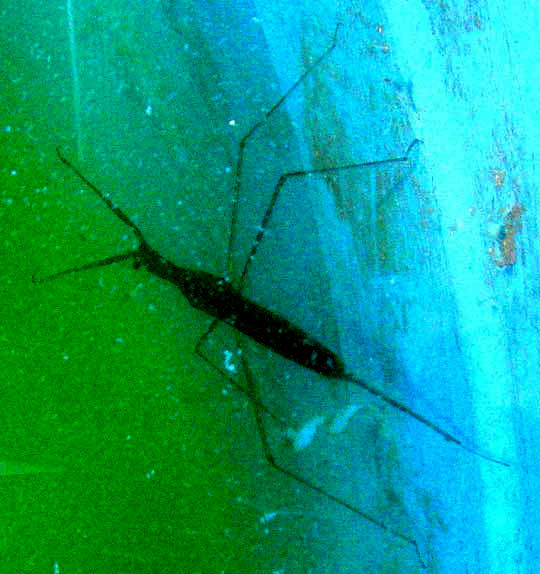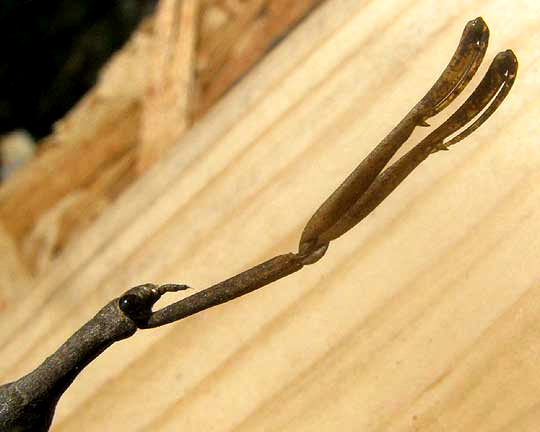Excerpts from Jim Conrad's
Naturalist Newsletter

from the September 8, 2013 Newsletter issued from the Frio Canyon Nature Education Center in the valley of the Dry Frio River in northern Uvalde County, southwestern Texas, on the southern border of the Edwards Plateau; elevation ~1750m (~5750 ft); N29.62°, W99.86°; USA
WATERSCORPION
The long, slender, walkingstick-like insects with preying-mantis-like front legs first caught my attention when each morning I'd find one or two on my satellite-dish solar cooker, usually dead. I couldn't imagine why the cooker might attract them until one day just below the water's surface in a blue plastic tube used to catch rainwater I saw what's shown below.

That's the same species as ends up on my solar cooker, and finally I understood: Flying at night the critter sees the silvery glow of starlight reflecting on the shiny aluminum sheeting attached to the satellite dish's parabolic surface, the reflection looks like a pool of water from above, and the insect dives into it -- maybe headfirst. At the top of this page you can see the live one from the rainwater tub.
The long, slender item at the critter's rear end isn't a stinger, but rather consists of two terminal filaments sometimes referred to as "urogomphi," which can be manipulated to form a "siphon" through which the submerged insect can take in air.
The stiff, slender object projecting away from the insect's head is one of the front two legs, the other being hooked to the side of my finger. Below, the front legs with their end joint doubled back and tipped with grappling-hook-like appendages are displayed on one found on the solar cooker:

Entomologists refer to such front legs as "raptorial forelegs," the word raptorial referring to leg modifications that help the insect grasp its prey while the prey is being devoured.
Volunteer identifier Bea in Ontario reminded me that this remarkable insect is a waterscorpion, sometimes also called a needle bug or water stick insect, genus RANATRA. It belongs to the Waterscorpion Family, the Nepidae, of the True Bug Order, the Hemiptera. Therefore, despite their mantis-like forelegs, waterscorpions aren't closely related to mantids at all, many experts now assigning mantids in their own order.
I say that Bea "reminded" me that these are waterscorpions because ten years ago when I was hermiting in the woods of southwestern Mississippi one spring morning I had the wonderful luck to watch about twenty waterscorpions recently emerged from the water as they dried themselves. {next entry}
Having seen the pictures and recognized the body parts for what they are, already we know the general features of the waterscorpion's life cycle: It's predatory on smaller aquatic animals, including tadpoles and small fish; it can fly; it hangs beneath the water's surface breathing through its siphon tube, prepared to grab prey with its "raptorial forelegs" and; while flying at night, it can confuse a solar cooker's shiny parabolic dish as a round pool of water, into which it is bound to plunge.
from the March 16, 2003 Newsletter issued from the woods just south of Natchez, Mississippi, USA
WATERSCORPIONS EMERGING
Last Sunday with the temperature nudging 80° (27°C) I sat beside a woodland pond wondering what amazing thing would happen. I didn't have long to wait.
Just off the pond's bank where the clear water was about 6 inches deep (15 cm), right below the surface, swam a fleet of three dark-brown, spidery insects about 2 inches long (50 mm). They looked very much like underwater Walking Sticks except that long, slender tubes were attached to their rear ends. They were Waterscorpions, completely unrelated to real scorpions, insects of the "true bug order," the Hemiptera, genus RANATRA.
Slowly and deliberately they sailed through the water paddling with their hind four legs while holding their two front legs before them like Praying Mantises. Every few seconds they'd pause and the tip of their rear-end tubes would tilt up to the water's surface to take in air.
After the three creatures had passed I looked around for more. About a dozen could be seen here and there, some of them hardly ever sending up their tubes for air, others never withdrawing them from the surface for more than a second or two. Some came into shallow water where the Mosquitofish swam away from them, for Waterscorpions can eat small fish.
Then I saw that on a nearby, partially submerged log, about twenty had completely emerged from the pond, climbed to the log's highest knot, and in two clusters had all oriented themselves toward the sun, posing their dark, stiff, gangling bodies at 45° angles. It was a strange and spooky sight. They looked like a fleet of Darth Vader's Death-Jets poised for take-off.
As I watched, other Waterscorpions emerged from the water, pulled themselves onto the log and joined the groups. The strange thing was that they didn't emerge from nymphal husks at the water's edge the way dragonflies or damselflies do when they metamorphose from their aquatic stages to their adult free-air stages. En masse these beings were simply pulling themselves from their underwater lives, becoming dry- land creatures and eerily gazing toward the sun.
As the insects dried they turned gray-brown. One by one an individual would suddenly flutter its wings which until then had lain concealed along the slender back, and then in a minute or so it would in a surprising whirr lift itself into the air. One by one they drifted sunward, the light catching in their wings transforming them into dazzling flares before vanishing into the forest's shadows.
What a magnificent emergence this was! I think I just happened to be in the right place at the right time to witness something majestic, for the next day I went back and found nothing of the like.